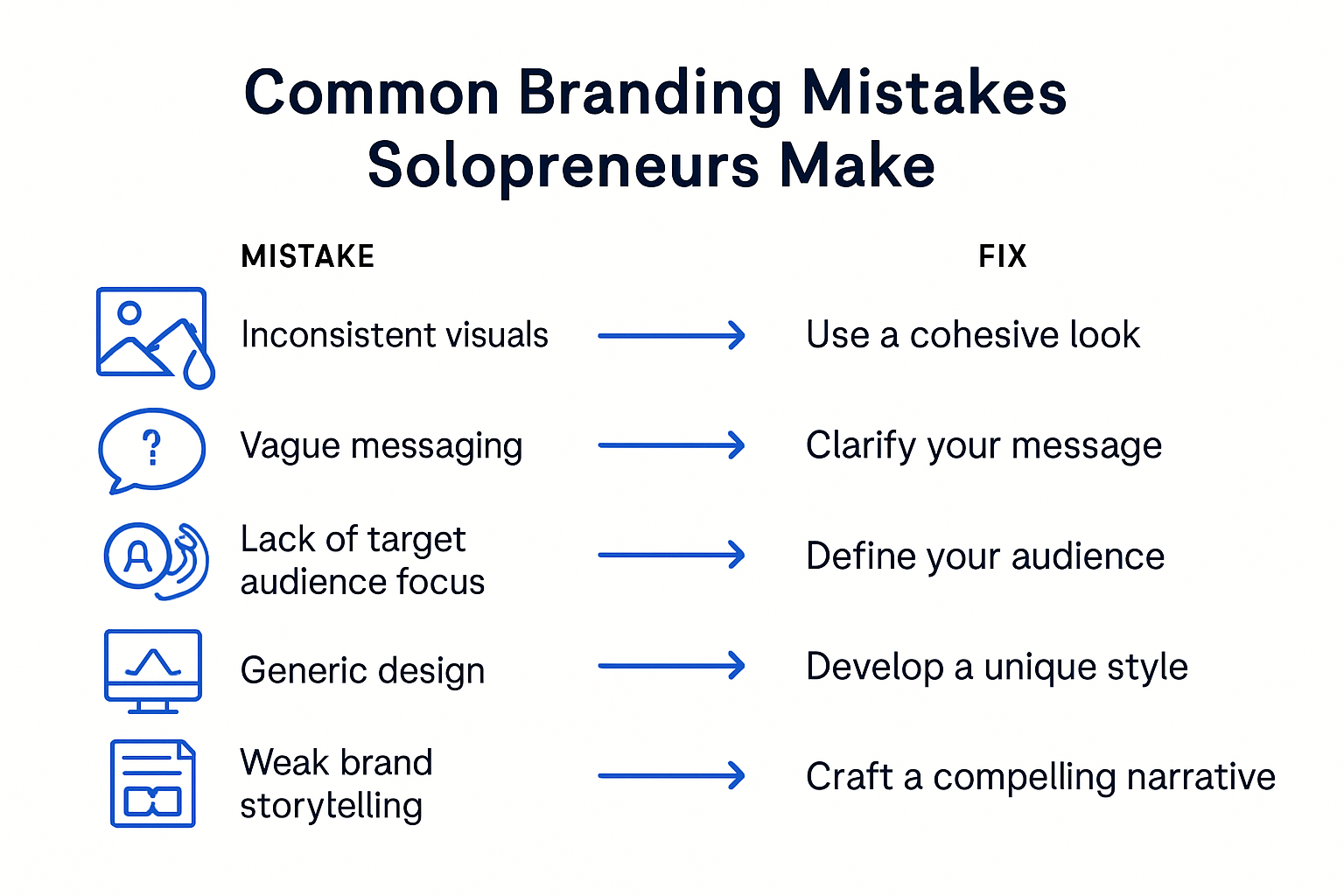
Branding mistakes to avoid. Most solopreneurs put hours into building their brand, hoping to stand out and attract the right clients. Yet business owners who ignore basic branding pitfalls can unintentionally sabotage their own efforts. Research shows that brand consistency alone can directly impact whether someone chooses to buy from you. Imagine investing all that energy only to be held back by a few simple mistakes. The biggest missed opportunities in branding are often hiding in plain sight.
Table of Contents: Branding Mistakes to Avoid.
- Ignoring The Power Of Consistency
- Misunderstanding Your Target Audience
- Neglecting Authentic Visual Identity
- Overlooking The Value Of Brand Storytelling
Quick Summary
| Takeaway | Explanation |
|---|---|
| Maintain Consistency Across Branding | Consistent visuals and messaging help build trust and recognition with potential clients. |
| Focus on a Specific Target Audience | Understanding your ideal clients allows for tailored branding that resonates strongly. |
| Develop an Authentic Visual Identity | Design should reflect your unique essence and resonate with your brand narrative. |
| Use Brand Storytelling Effectively | An engaging brand story connects emotionally with clients and promotes trust. |
| Continuously Research Your Audience | Regularly reassessing your audience keeps your brand relevant and effective in a changing market. |

Ignoring the Power of Consistency
Consistency represents the cornerstone of powerful branding for solopreneurs. When you fail to maintain a uniform visual and messaging approach across different platforms, you risk confusing potential clients and diluting your professional image.
Visual Brand Consistency: Branding Mistakes to Avoid
Visual branding goes beyond simply selecting attractive colors and logos. Research from the Journal of Business Research revealed that brand consistency directly impacts consumer purchase intentions and perceived value. For solopreneurs, this means every visual touchpoint matters. Your website, social media profiles, business cards, email signatures, and marketing materials must reflect a cohesive aesthetic.
Here is a summary table highlighting key elements to consider for achieving visual brand consistency as discussed in this section:
| Branding Element | Area of Application | Consistency Best Practice |
|---|---|---|
| Color Palette | Website, social media, materials | Use same colors across all platforms |
| Typography | Logos, headers, content | Stick to chosen fonts and styles |
| Image Style | Graphics, photos, illustrations | Maintain a cohesive visual style throughout |
| Logo Usage | Business cards, email, website | Position and size logo consistently |
| Graphic Elements | Icons, buttons, backgrounds | Repeat core design elements in all media |
Think of your brand like a signature outfit. Just as a well curated wardrobe communicates intentionality, your visual branding should tell a consistent story. This means using the same color palette, typography, image style, and graphic elements everywhere you appear professionally. Inconsistent visuals signal amateurism and can erode potential client trust.
Messaging and Tone Alignment: Branding Mistakes to Avoid.
Consistency extends beyond visual elements into your communication style. Your brand voice should remain uniform whether you are creating a social media post, writing a blog, sending an email, or presenting a proposal. Frequent shifts in tone confuse your audience and make your brand feel unreliable.
Successful solopreneurs develop a distinct communication persona that resonates with their target market. This means choosing a consistent tone whether you are professional and authoritative, warm and approachable, or innovative and edgy. The key is selecting a voice that authentically represents your professional identity and sticking to it across all platforms.
Strategic Brand Repetition
Repetition builds recognition. By consistently presenting your brand elements, you help potential clients quickly recognize and remember you. This psychological principle of familiarity makes your brand more memorable and trustworthy. Marketing experts suggest that consumers need multiple exposures to a brand before they develop meaningful recognition and trust.
For solopreneurs, this means deliberately and strategically repeating your core visual and messaging elements. Use your signature color scheme, logo placement, and communication style as a subtle but consistent backdrop to everything you produce professionally. Over time, these repeated elements create a strong, recognizable brand identity that sets you apart in a crowded marketplace.
Remember: Consistency is not about being rigid, but about creating a reliable and professional brand experience that makes potential clients feel confident in choosing your services.
Misunderstanding Your Target Audience
Many solopreneurs make a critical branding error by attempting to appeal to everyone instead of focusing on a specific audience. Marketing research from Penn State University emphasizes that failing to define and understand your target audience can lead to ineffective marketing efforts.
The Perils of Generalized Messaging
Broad, generic messaging dilutes your brand’s impact. When you try to speak to everyone, you ultimately speak to no one effectively. Successful solopreneurs recognize that precision in audience targeting is not about limiting potential clients but about creating meaningful connections with those most likely to value your services.
This table compares key differences between generalized messaging and targeted messaging to clarify why precise audience targeting is essential:
| Feature | Generalized Messaging | Targeted Messaging |
|---|---|---|
| Audience Reach | Broad, non-specific | Specific, well-defined |
| Connection Level | Weak, superficial | Deep, personalized |
| Messaging Effectiveness | Low | High |
| Brand Impact | Diluted, forgettable | Memorable, meaningful |
| Example Use Case | “Everyone needs wellness” | “Midcareer professionals with burnout” |
Harvard Business School research highlights the importance of market segmentation. This strategy involves organizing consumers with similar needs and preferences into distinct groups, enabling you to provide personalized experiences that resonate deeply.
Developing Audience Personas: Branding Mistakes to Avoid
Creating detailed audience personas is more than a marketing exercise. It is a strategic approach to understanding the specific challenges, desires, and motivations of your ideal clients. Your personas should include demographic information, professional background, pain points, and communication preferences.
For instance, a wellness coach targeting midcareer professionals experiencing burnout would craft very different branding messages compared to one focusing on recent college graduates seeking lifestyle optimization. The more precisely you can define your audience, the more effectively you can tailor your brand messaging.
Continuous Audience Research: Branding Mistakes to Avoid
Target audience understanding is not a one time task but an ongoing process. University of Rhode Island Small Business Development Center recommends regularly reassessing your audience segments. Market dynamics shift, and your ideal client profile may evolve.
Effective solopreneurs stay curious about their audience. They engage in continuous learning through client surveys, feedback sessions, social media interactions, and market trend analysis. This commitment to understanding allows for dynamic brand positioning that remains relevant and compelling.
Remember: Your brand is not about attracting everyone. It is about creating a magnetic connection with the right people who will find extraordinary value in your unique offerings.
Neglecting Authentic Visual Identity
Your visual identity represents the visual DNA of your personal brand. For solopreneurs, an authentic visual identity is not just about looking professional. It is about creating a genuine representation of your unique professional personality and core values.
Beyond Generic Design Templates: Branding Mistakes to Avoid
Design research from Adobe suggests that authentic design communicates more than aesthetics. It tells a story about who you are and what you represent. Many solopreneurs make the mistake of using generic templates or copying competitor designs, which ultimately makes their brand blend into the background.
Authentic visual identity requires thoughtful design choices that reflect your individual professional essence. This means selecting colors, fonts, and imagery that genuinely resonate with your personal brand narrative. Your visual elements should feel like a natural extension of your professional personality.
Strategic Visual Storytelling
Branding experts from Nielsen Norman Group emphasize that visual design is a powerful communication tool. Every visual element communicates something about your brand. Your logo, color palette, typography, and image style should work together to create a cohesive narrative that speaks directly to your target audience.
Consider how each visual element represents your professional values. A wellness coach might choose soft, calming colors and organic shapes to communicate nurturing energy. A technology consultant might opt for clean lines and bold, modern typography to signal precision and innovation. Your visual choices should feel intentional and aligned with your professional identity.
Maintaining Visual Consistency and Evolution: Branding Mistakes to Avoid
Authentic visual identity is not static. It should evolve as you grow professionally while maintaining core recognizable elements. This means periodically reviewing your visual branding to ensure it continues to accurately represent your current professional journey.
Solopreneurs should approach visual branding as a dynamic process. Regular brand audits help ensure your visual identity remains fresh and relevant. However, these updates should be subtle refinements that build upon your established visual foundation, not complete overhauls that confuse your existing audience.
Remember the branding mistakes to avoid: Your visual identity is a powerful nonverbal communication tool. It should invite your ideal clients into your professional world, telling a compelling story about who you are and the unique value you offer.

Overlooking the Value of Brand Storytelling
Brand storytelling transforms your professional narrative from a simple service offering into a compelling journey that connects emotionally with potential clients. Many solopreneurs underestimate the power of storytelling, viewing it as a marketing afterthought rather than a critical brand strategy.
The Science of Storytelling
Research from the University of Western Australia reveals a compelling statistic: 55% of consumers who resonate with a brand’s story are more likely to make a purchase. This underscores the profound impact storytelling has on consumer decision making.
Stanford Graduate School of Business insights highlight the importance of crafting authentic narratives. Jennifer Aaker, a renowned professor, identifies common storytelling pitfalls that solopreneurs must avoid, such as using excessive jargon and failing to create genuine emotional connections.
Constructing Your Authentic Narrative: Branding Mistakes to Avoid
Your brand story is more than a chronological account of your professional journey. It is a strategic narrative that communicates your unique value, core values, and professional philosophy. Learn more about crafting a powerful brand messaging strategy that resonates with your target audience.
Effective storytelling involves three key elements: your professional origin, the challenges you help clients overcome, and the transformative impact of your services. A wellness coach might share how personal health struggles inspired their mission to help others. A technology consultant could narrate how solving a complex problem for an early client sparked their consulting career.
Psychological Dimensions of Brand Storytelling
Psychological research published in Frontiers in Psychology applies Aristotle’s rhetorical theory to brand storytelling. The study suggests incorporating ethos (credibility), pathos (emotional appeal), and logos (logical reasoning) to enhance brand sincerity and trust.
This means your story should not just describe what you do, but why you do it. It should demonstrate your expertise, evoke emotional connection, and provide logical evidence of your capabilities. Your narrative becomes a powerful tool that transforms potential clients from skeptical observers to engaged believers in your professional mission.
Remember: Your brand story is not about perfection. It is about authenticity, vulnerability, and the unique perspective you bring to your professional domain. When told compellingly, your story becomes your most powerful marketing instrument.
Frequently Asked Questions
What are the common branding mistakes to avoid for solopreneurs?
Common branding mistakes include ignoring brand consistency, misunderstanding the target audience, neglecting an authentic visual identity, and overlooking the importance of brand storytelling. Each of these can dilute brand effectiveness and hinder client attraction.
Why is consistency important in branding?
Consistency in branding fosters trust, recognition, and immediate recall among potential clients. By maintaining uniform visuals and messaging across platforms, solopreneurs create a professional image that resonates with their audience.
How can I define my target audience effectively?
To define your target audience effectively, develop detailed audience personas based on demographics, professional backgrounds, pain points, and desires. Regularly conduct audience research to keep your understanding up to date as market dynamics evolve.
What role does storytelling play in branding?
Storytelling is crucial in branding as it creates an emotional connection with your audience. A compelling brand story highlights your unique value proposition and engages potential clients, making them more likely to trust and connect with your brand.
Stop Sabotaging Your Brand: Let AI Power Your Next Level
Have you realized how easy it is to fall into the branding traps described above? Inconsistent visuals, scattered messaging, and generic design are common struggles for solopreneurs trying to juggle everything alone. The frustration of scattered tools and overwhelming manual work can make consistency and authentic engagement feel out of reach. But your brand deserves better. The right technology makes it possible to align every touchpoint, streamline client experiences, and preserve the personal touch that sets you apart.

It is time to break free from burnout and build the business reputation you have always wanted. With Fluum.ai’s all-in-one platform, you gain access to an AI co-founder that helps you build a brand, keep your messaging consistent and manage your storefront – without technical hassle. You can automate repetitive tasks, ensure every client interaction feels intentional, and focus on your growth. Visit https://fluum.ai/pricing now to see how easy it is to transform your branding and operate like a true professional. Take control today before another branding mistake holds you back. Thanks for learning about the branding mistakes to avoid.
Recommended
- How Do I Use AI to Grow My One-Person Business?
- What Are the Best AI Tools for Freelancers in 2025?
- How Do I Determine the Value of My Digital Product?
- What Are Some Free Ways to Promote Digital Products Online?
- How Do I Start Selling Digital Products Online?



